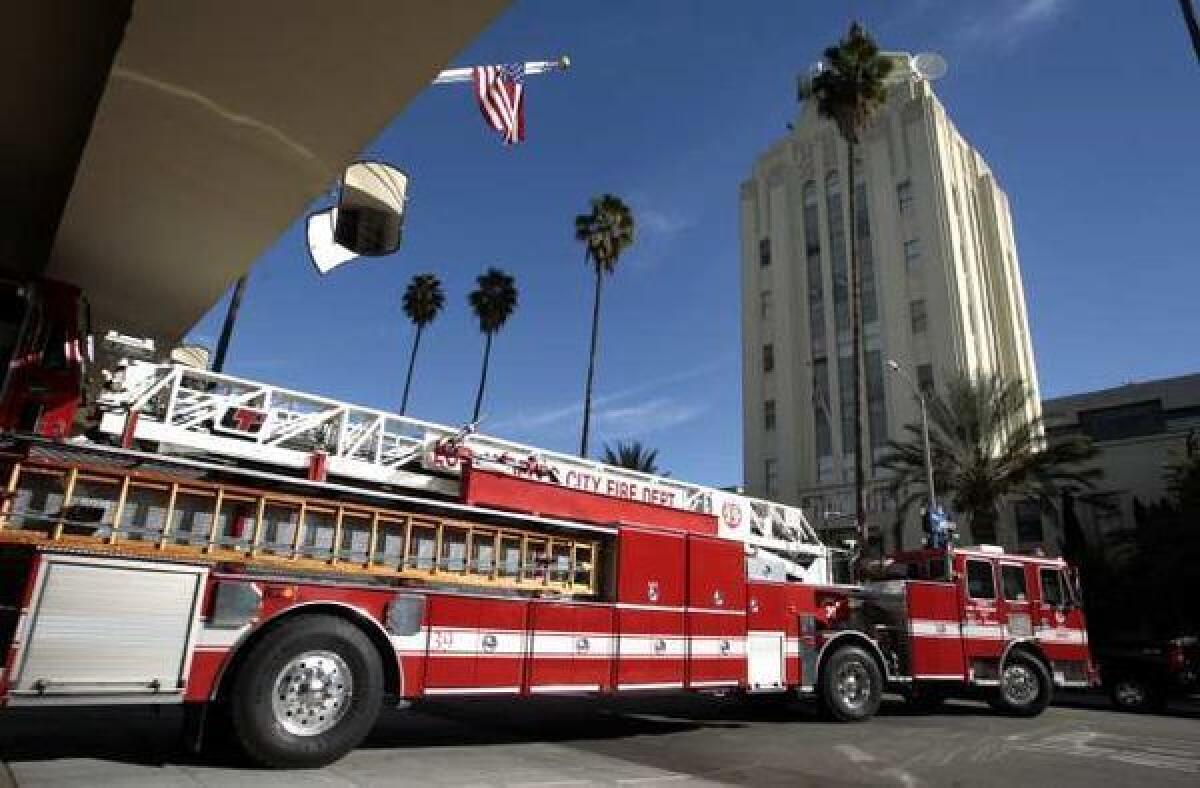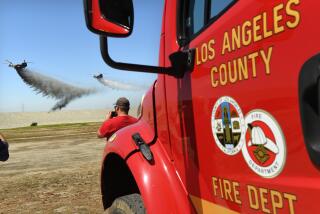LAFD chief to reassign many firefighters to rescue ambulances

Los Angeles Fire Chief Brian Cummings said Tuesday that he will reassign dozens of firefighters from engines to rescue ambulances beginning next month to handle an increase in medical emergencies.
The sudden action, coming after months of criticism over the agency’s 911 response times and Cummings’ leadership, drew immediate opposition from labor groups representing firefighters and department commanders, who warned the change would put firefighters at greater risk.
City fire commissioners and a key City Council member also questioned the plan, which calls for adding 11 new ambulances.
Cummings said the change is needed to reshape the Fire Department to match the agency’s workload, which has shifted from fighting fires to primarily responding to calls for emergency medical help. Those calls now account for more than 80% of 911 responses, according to department officials and an independent data analysis by The Times.
Fire officials say the proportion of medical emergency calls continues to increase. In the first two months of this year, emergency medical service calls grew 6.2%, compared with the same time period last year, Cummings said in a written report.
“This is an EMS provider agency,” the chief told the fire commission. “That is our core business.”
When responding to fires and medical emergencies, the LAFD often sends a ladder truck paired with a fire engine — a combination known as a light force. The team is staffed by six firefighters, who perform a variety of roles.
The chief’s plan, which he said takes effect May 5, would reassign about 60 firefighters working different shifts on 22 light forces citywide to ambulances. The firefighters are emergency medical technicians, not licensed paramedics with advanced lifesaving skills. They would staff non-paramedic units that provide basic medical treatment and respond to thousands of less serious emergencies each year.
The change would increase that class of ambulances by about one-third, to 45, freeing up nearly 90 overtaxed paramedic units to respond to the most life-threatening calls, officials said.
But Capt. Frank Lima, president of United Firefighters of Los Angeles City, which represents the rank and file, said the chief’s proposal will put fire engine crews in danger by cutting back personnel needed to safely attack structure fires. Taking a firefighter away from a light force could affect search-and-rescue operations, the ability to hoist heavy ladders onto buildings and cut holes in roofs to release dangerous buildups of heat and toxic smoke, Lima said.
“It sounds good on paper,” Lima said of the plan. “But to have one less firefighter, it absolutely puts our firefighters at risk.”
Union leaders also expressed skepticism about the data underpinning the chief’s plan and called for a more thorough, written analysis of the change. Cummings said that would have to come after the changes are in place.
The chief’s sudden push for the changes drew questions from Fire Commissioner Alan Skobin, who suggested the plan may need more scrutiny. The panel did not stop the chief from moving forward, but did set a special meeting for April 25 to consider additional information on the plan.
Skobin, a former city police commissioner, said the LAPD typically presented detailed written reports before any significant change in operations. Though Cummings said the plan was based on detailed data analysis, the only material circulated at the commission meeting was a “draft” report of less than 1 1/2 pages.
The department’s data analysis has been under increased scrutiny since March 2012, when fire officials admitted to publishing response times that made it appear rescuers arrived at emergencies faster than they actually did. A task force of experts overseen by Skobin found that fire officials responsible for crunching the numbers were poorly qualified and that previous departmental data analysis “should not be relied upon.”
A series of subsequent Times investigations found delays in processing 911 calls and summoning the nearest medical rescuers from other jurisdictions, as well as wide gaps in response times in different parts of the city. The problems worsened after cutbacks ordered by the mayor and the City Council during the economic downturn cost the department more than 300 positions.
The proposal was also called into question Tuesday by Councilman Mitchell Englander, chairman of the Public Safety Committee. He said he will summon Cummings before the committee to explain the changes.
“We know that the data has been flawed and has been wrong,” Englander told The Times. “I’d like to see the numbers to back it up.”
Cummings previously weighed a plan to seek additional funding from the City Council to restore about 300 agency positions eliminated in recent years. But he withdrew the restoration plan last month, saying it needed more work.
Lima said that the union is not opposed to adding ambulances, but that Cummings should be seeking additional funds to pay for ambulance staffing.
“Although the City Council has promised additional revenue, it’s not there,” Cummings said. “I can’t print money.”
More to Read
Sign up for Essential California
The most important California stories and recommendations in your inbox every morning.
You may occasionally receive promotional content from the Los Angeles Times.













